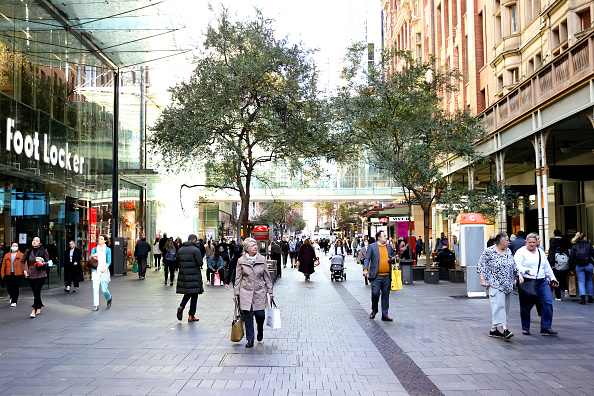Australia to outshine its peers in ‘surprisingly resilient’ global economy
It’s a slow start for 2024 but the longer term outlook for the local economy is strong
The International Monetary Fund (IMF) has described the global economy as “surprisingly resilient” amid rapid interest rate rises to quell high inflation since 2022, post-pandemic supply chain disruptions, a short-term spike in energy prices due to the war in Ukraine and increased geopolitical tensions involving China and the Middle East.
The IMF’s biannual World Economic Outlook report says the world has so far avoided stagflation and recession, with large pandemic savings enabling households to cope with higher rates and inflation, and strong immigration in advanced economies creating unusually tight labour markets.
IMF economic counsellor Pierre-Olivier Gourinchas said most indicators point to a soft landing for the global economy and the IMF now expects “less economic scarring from the pandemic”. He noted that markets had reacted exuberantly in recent weeks to the prospect of central banks lowering interest rates soon.
However, the IMF says global growth will moderate over the next five years to its lowest level in decades. It projects 3.2 percent global growth in 2024 and 2025, the same pace as 2023, with still-high borrowing costs, the withdrawal of fiscal support and weak productivity growth weighing economic activity down.
Australia is expected to underperform other advanced economies, especially the United States, this year but will surge beyond them from 2025. The IMF predicts annual gross domestic product (GDP) growth of 1.5 percent in Australia in 2024, which is well below our long-term pre-pandemic average of 2.5 percent. The US is expected to book above-average growth of 2.7 percent in 2024 and the world’s advanced economies are tipped to average 1.7 percent growth.
Australian economic growth will then move above other advanced economies and maintain upward momentum through til 2029. The IMF predicts 2 percent GDP growth for Australia in 2025 and 2.3 percent in 2029. For the US, the IMF expects 1.9 percent growth in 2025 and 2.1 percent in 2029. For the advanced economies in aggregate, the IMF forecasts 1.8 percent growth in 2025 and 1.7 percent in 2029.
The IMF said higher interest rates had had less effect on the US economy compared to Australia because most US mortgages are on long-term fixed rates and household debt has been lower since the global financial crisis. In Australia, most loans are on variable rates and therefore immediately impacted by every rate rise, household debt is high, and housing supply is restricted.
“The exceptional recent performance of the United States is certainly impressive and a major driver of global growth, but it reflects strong demand factors as well, including a fiscal stance that is out of line with long-term fiscal sustainability,” said Mr Gourinchas.
An example of unusual fiscal policy is the Inflation Reduction Act, which includes US$369 billion in new spending to encourage green energy investment. “This raises short-term risks to the disinflation process, as well as longer-term fiscal and financial stability risks for the global economy since it risks pushing up global funding costs,” he said.
While things are going well now, Mr Gourinchas said risks to global economic progress remain.
“On the downside, new price spikes stemming from geopolitical tensions, including those from the war in Ukraine and the conflict in Gaza and Israel, could, along with persistent core inflation where labour markets are still tight, raise interest rate expectations and reduce asset prices. A divergence in disinflation speeds among major economies could also cause currency movements that put financial sectors under pressure.”
Mr Gourinchas said growth in China could falter, hurting trading partners, without a comprehensive response to its property sector downturn. “Domestic demand will remain lacklustre for some time unless strong measures and reforms address the root cause. Public debt dynamics are also of concern, especially if the property crisis morphs into a local public finance crisis.”
He also noted that weak productivity growth remains a challenge for the whole world and “much hope rests on artificial intelligence delivering strong productivity gains in the medium term”.
This stylish family home combines a classic palette and finishes with a flexible floorplan
Just 55 minutes from Sydney, make this your creative getaway located in the majestic Hawkesbury region.
Continued stagflation and cost of living pressures are causing couples to think twice about starting a family, new data has revealed, with long term impacts expected
Australia is in the midst of a ‘baby recession’ with preliminary estimates showing the number of births in 2023 fell by more than four percent to the lowest level since 2006, according to KPMG. The consultancy firm says this reflects the impact of cost-of-living pressures on the feasibility of younger Australians starting a family.
KPMG estimates that 289,100 babies were born in 2023. This compares to 300,684 babies in 2022 and 309,996 in 2021, according to the Australian Bureau of Statistics (ABS). KPMG urban economist Terry Rawnsley said weak economic growth often leads to a reduced number of births. In 2023, ABS data shows gross domestic product (GDP) fell to 1.5 percent. Despite the population growing by 2.5 percent in 2023, GDP on a per capita basis went into negative territory, down one percent over the 12 months.
“Birth rates provide insight into long-term population growth as well as the current confidence of Australian families,” said Mr Rawnsley. “We haven’t seen such a sharp drop in births in Australia since the period of economic stagflation in the 1970s, which coincided with the initial widespread adoption of the contraceptive pill.”
Mr Rawnsley said many Australian couples delayed starting a family while the pandemic played out in 2020. The number of births fell from 305,832 in 2019 to 294,369 in 2020. Then in 2021, strong employment and vast amounts of stimulus money, along with high household savings due to lockdowns, gave couples better financial means to have a baby. This led to a rebound in births.
However, the re-opening of the global economy in 2022 led to soaring inflation. By the start of 2023, the Australian consumer price index (CPI) had risen to its highest level since 1990 at 7.8 percent per annum. By that stage, the Reserve Bank had already commenced an aggressive rate-hiking strategy to fight inflation and had raised the cash rate every month between May and December 2022.
Five more rate hikes during 2023 put further pressure on couples with mortgages and put the brakes on family formation. “This combination of the pandemic and rapid economic changes explains the spike and subsequent sharp decline in birth rates we have observed over the past four years,” Mr Rawnsley said.
The impact of high costs of living on couples’ decision to have a baby is highlighted in births data for the capital cities. KPMG estimates there were 60,860 births in Sydney in 2023, down 8.6 percent from 2019. There were 56,270 births in Melbourne, down 7.3 percent. In Perth, there were 25,020 births, down 6 percent, while in Brisbane there were 30,250 births, down 4.3 percent. Canberra was the only capital city where there was no fall in the number of births in 2023 compared to 2019.
“CPI growth in Canberra has been slightly subdued compared to that in other major cities, and the economic outlook has remained strong,” Mr Rawnsley said. “This means families have not been hurting as much as those in other capital cities, and in turn, we’ve seen a stabilisation of births in the ACT.”
This stylish family home combines a classic palette and finishes with a flexible floorplan
Just 55 minutes from Sydney, make this your creative getaway located in the majestic Hawkesbury region.


















